Cold brew coffee is a great way to get your dose of refreshing coffee. It sounds deceptively simple to brew – but brewing it can be tricky. That’s why you need the best cold brew coffee makers. The process can stay simple for the user, while the coffee maker does all the heavy lifting.
Our prize is the coffee concentrate delivered as cold brew. You probably already know this, but for the uninitiated, cold brew is not the same as chucking ice cubes into your coffee. It’s an intricate process where coffee extraction is done without the use of hot water.
Read more: Best coffee beans for cold brew
Let’s take a look at the top cold brew coffee makers available.
- Takeya Cold Brew Coffee Maker
- Toddy Cold Brew System
- Asobu Cold Brew Coffee Maker
- OXO Cold Brew Coffee Maker Good Grips
- County Line Kitchen Cold Brew Mason Jar Coffee Maker
- NutriChef Nitro Cold Brew Coffee Maker
- Royal Brew Nitro Cold Brew Coffee Maker
- OXO BREW Compact Cold Brew Coffee Maker
- Cold Bruer Drip Coffee Maker B1
- Dash Cold Brew Coffee Maker DCBCM550BK
- Primula Burke Deluxe Cold Brew Iced Coffee Maker
- Hario Mizudashi Cold Brew Coffee Pot
- Willow & Everett Commercial Cold Brew Coffee Maker
- Yama Glass Cold Brew Maker
Cold Brew Coffee Maker Reviews – Top Choices
1. Takeya Cold Brew Coffee Maker — Editor’s Choice
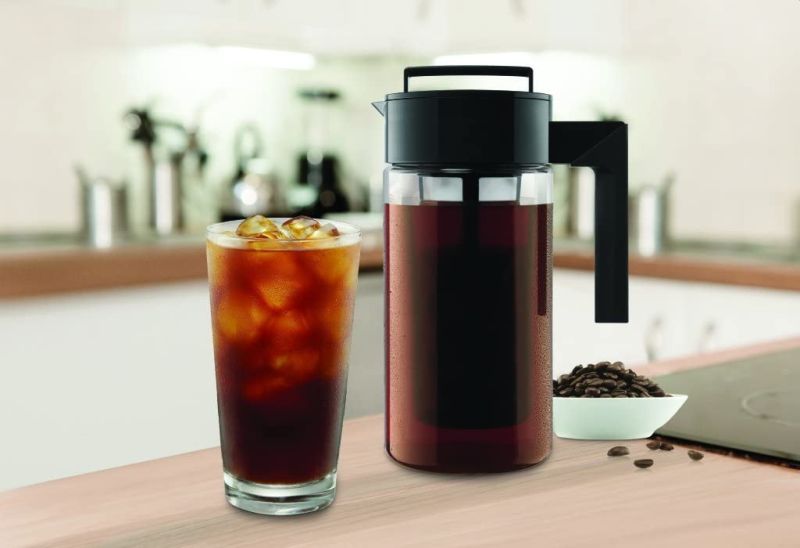
Our top choice is the remarkably well-made Takeya Cold Brew Coffee Maker. It has been a favorite for cold brew lovers for a long time and has proven itself to be dependable. Takeya Deluxe Cold Brew Coffee Maker has a rather simple construction.
Its body/pitcher is made from BPA-free tritan plastic. Accompanying that is a fine-mesh coffee filter that does a remarkable job at keeping grounds out of the concentrate. Takeya coffee maker is available in 1-quart and 2-quart sizes. Both containers are designed to fit easily into refrigerator bottles.
A silicone non-slip handle grip makes it convenient to use the pitcher and the coffee concentrate. Another benefit of the tritan plastic body is that it can withstand heat. So if you intend to choose the cold brew for hot beverages, they’ll get along just fine! To be clear, that means the bottle can handle hot liquids – it isn’t microwave safe.
The lid forms an airtight cover over the pitcher, so the coffee concentrate stays fresh for longer. The company claims you can keep the concentrate for two weeks. Takeya Cold Brew Coffee Maker is dishwasher safe so cleaning and maintenance become so much easier and convenient.
Pros
- BPA-free construction
- Cheap
- Easy to use
- Dishwasher-safe and easy to maintain
Cons
- Coffee concentrate can be weaker compared to its competitors
2. Toddy Cold Brew System
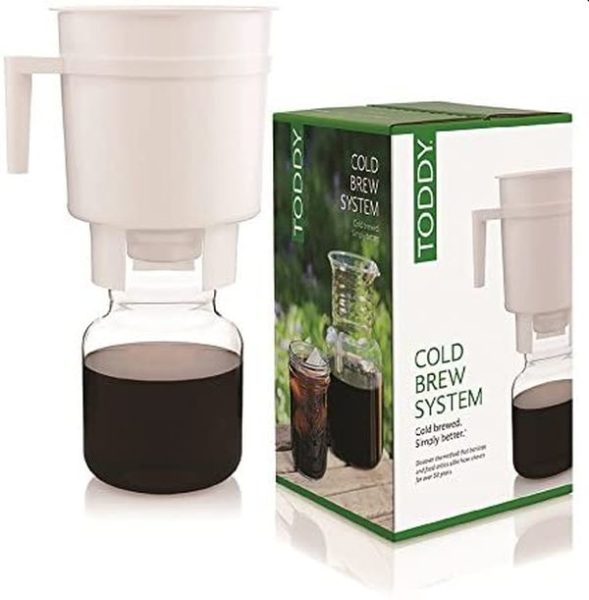
Toddy Cold Brew System makes strong and smooth coffee concentrate. The setup involves two major components, the brew bucket, and the carafe. Unlike most other brew methods, Toddy involves another set of steps with the use of filters.
The brew basket will have paper liners and filter pads. A rubber stopper keeps them all in place until you’re ready to move the cold brew to the decanter. All of this makes the process a bit more complicated. Additionally, you’ll have to continuously keep buying the liners and filter pads.
However, most people are willing to ignore those extra steps considering the strong and smooth brew this makes. A more compact system would perhaps be preferable because the brewing put up an odd look. That’s the plastic body of the brewer isn’t much of a sight.
Toddy Cold Brew System uses a BPA-free brewer and glass decanter. The paper filters, felt filter, and stopper are readily available.
Pros
- Strong and smooth coffee concentrate
- Simple to use
Cons
- Could use a better look
3. Asobu Cold Brew Coffee Maker
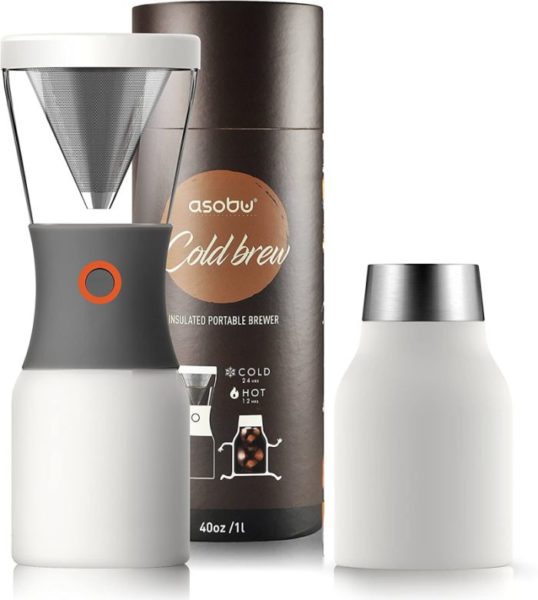
Asobu Cold Brew Coffee Maker is one of the better looking cold brew coffee makers. It’s not all about the looks though, the design is sensible as well and considers usability. The brew chamber is made from tritan plastic and is accompanied by a fine mesh filter. The coffee filter is made from 18/8 food grade stainless steel.
According to the company, the filter is fine enough to allow for the use of conventional medium ground coffee as opposed to the very coarse grind that cold brew usually prefers. It’s an interesting approach, though I’ll still suggest sticking with a coarse grind.
Once the coffee is done brewing, press the button and the coffee concentrate will flow to the decanter. The carafe too is made from 18/8 stainless steel and is vacuum insulated to keep the coffee concentrate cold. It comes with a spill proof lid so you can carry the carafe along.
One of the best features of the Asobu Cold Brew Coffee Maker is its looks. It has a modern design and decent, elegant looks. This is very likely the best looking cold brew coffee maker available. And honestly, that matters. I wish other coffee makers would take a cue and pick up the path to more decent looks.
Pros
- Excellent looks and design
- Carafe and filter made from 18/8 stainless steel
- Carafe is double-walled insulated and spill-proof
Cons
- Only brews a small volume
- It might be necessary to add ice to the carafe to cool the brew (not much use refrigerating because of insulation)
4. OXO Cold Brew Coffee Maker Good Grips
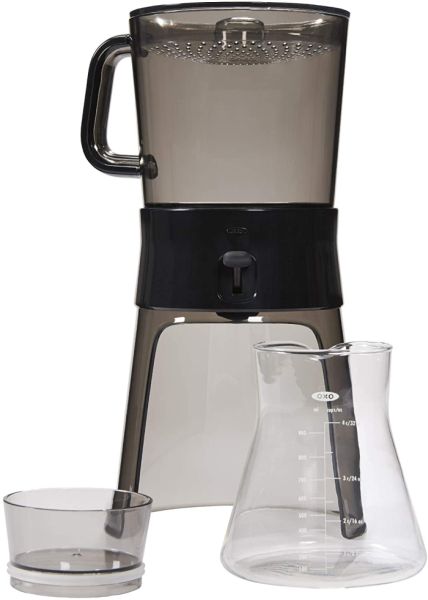
OXO Cold Brew Coffee Maker Good Grips is a popular and well-engineered pick for cold brew coffee. This cold brew maker comes with a good range of features to offer convenience and easier operation. An interesting aspect is the use of the “rainmaker” lid.
The showerhead-style design of the lid pours water evenly over the grounds. In theory, this should ensure that coffee grounds are evenly soaked. It’s a useful feature often seen in automatic pour over coffee makers, though I’m not entirely sure how useful it is for cold brew. Coffee grounds are going to get plenty of steeping time as it is.
Once brewing is done, you can hit the “brew release” switch that drains the concentrate into a borosilicate glass carafe. OXO has included a stopper for the carafe to make storage more convenient.
OXO Cold Brew Coffee Maker Good Grips makes smooth and flavorful cold brew. You will need paper filters with this coffee maker to work along with the stainless steel mesh filter. The circular-cut replacement filters are overpriced. Though for all practical purposes, they’re no different than regular paper filters.
Pros
- Easy to use coffee maker
- Compact, well-designed machine
- Pouring valve is a nice touch
Cons
- Expensive compared to its competition
- The valve has a risk of developing leaks, though it’s rare
5. County Line Kitchen Cold Brew Mason Jar Coffee Maker
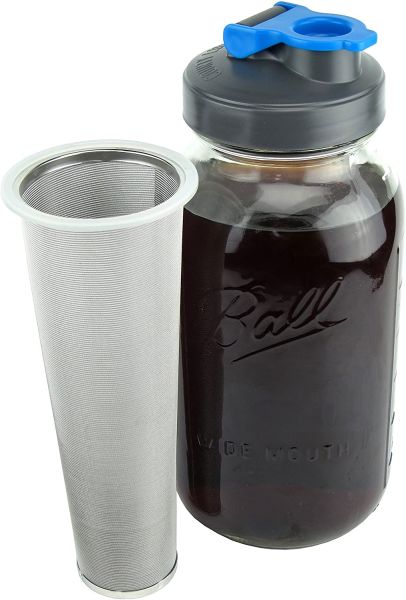
Take the classic route and get your cold brew in a mason jar. You can brew plenty of concentrate and the mason jar is a pretty neat way of storing it. And of course, you can use the jar for other things if you feel like it.
County Line Kitchen Cold Brew Mason Jar Coffee Maker uses a mason jar as the carafe and includes a stainless steel filter. When your cold brew is ready, simply remove the filter and let the concentrate stay in the mason jar.
To help along in its cold brew duties, they’ve made a small change to the lid of the jar. The lid includes a flip cap for easier pouring. Along with different sized jars, lids with handles are also available, so take your pick!
Pros
- Simple, convenient setup
- Minimal space required
- Mason jar makes it easier to use
Cons
- Concentrate can be weak
6. NutriChef Nitro Cold Brew Coffee Maker
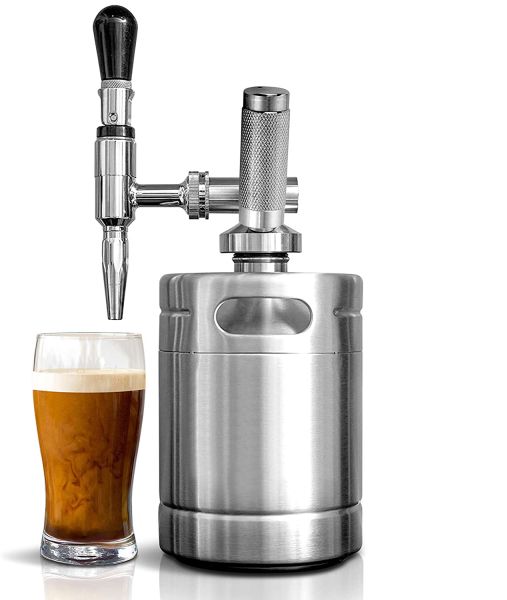
The Nitro cold brew coffee maker by NutriChef is one of the better products in the commercial cold brewing category. With a sleek design and a good enough liquid capacity, this product will meet your coffee needs in an efficient manner.
This coffee brewer is made using food grade S/S 304 rust-proof stainless steel, which gives it a stylish look as well as adds to the durability of the product.
This product has an upgraded stout creamer faucet that comes with a pressurized valve for cold-brew coffee infusion. This is where the cold-brewed coffee is infused with the combination of nitrogen gas – giving a creamy and stout-like effect to your beverage.
The Nitro cold brew coffee maker has a liquid capacity of 64 oz. Just with a slight addition of Nitrogen to your beverage, you can sit back and enjoy the refreshing coffee taste from your cold brew coffee maker.
By adding Nitrogen, you can get a more smooth cup of coffee with better taste, flavor and a creamy topping of foam.
Pros
- 64. oz capacity is good for small commercial environments
- Nitro cold brew gives better taste
- Stainless Steel design enhances condensing and durability
- Easy to clean with brushes that come with the product
- Affordable
Cons
- If it is filled up to its capacity, there is no room for Nitrogen gas and it might leak if left unattended overnight
7. Royal Brew Nitro Cold Brew Coffee Maker (Nitro Cold Brew At Home)
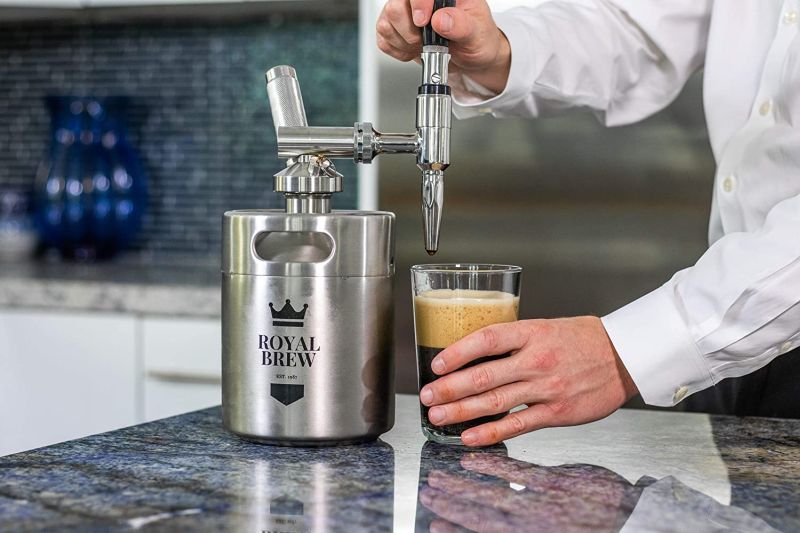
Cold brew has never been so hot as with the nitro cold brew coffee. A touch of nitrogen gives the coffee a wonderful head, in an approach that’s inspired by draught beer. Though a hit commercially, nitro cold brew coffee is possible at home once you get the necessary equipment.
Good news is, it isn’t that expensive. It can take some getting used to, but it’s easy to use as well. Royal Brew Nitro Cold Brew Coffee Maker Home Keg Kit System has everything you need for nitro cold brew at home.
Well, you’ll need to buy one of these other cold brew coffee makers as well. This one just delivers nitrogen; it doesn’t brew coffee.
Add coffee to the keg, put up two nitrogen capsules, and give it some time in the refrigerator. Your nitro cold brew is ready to roll. The maximum coffee it can handle is 48 oz, though models with other sizes are available as well.
Royal Brew Nitro Cold Brew Coffee Maker uses a 64 oz keg made with food grade stainless steel. It holds the cold brew ready to dispense on demand.
Pros
- Nitrogen treatment makes coffee smooth
- Well-built system
- Easy to use and easy to clean
Cons
- Can feel like too much of a hassle
- Must allow at least one hour for keg and coffee in refrigerator to let it infuse
8. OXO BREW Compact Cold Brew Coffee Maker
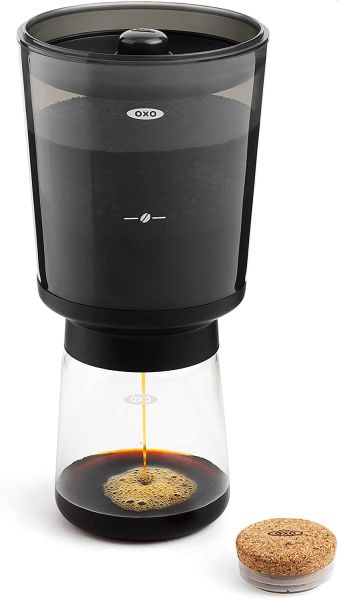
OXO BREW Compact Cold Brew Coffee Maker takes its lessons from the OXO Good Grips coffee maker and puts them into a compact body. The design and function ideas are quite similar, including the rainmaker lid to evenly distribute water over coffee grounds.
The larger difference is that there is no button to pour the concentrate. Instead, the concentrate starts pouring when the brewer is placed over the carafe. An included lid keeps the coffee maker covered while brewing. When you’re ready, remove the lid, align the markings, and let coffee flow from the brewer into the carafe.
Pros
- Simple and compact system
- Brewer and carafe can nest for easier storage
- Borosilicate glass carafe and cork stopper
Cons
- The glass carafe is at risk of breaking/chipping and replacements are tough to come by (if at all)
9. Cold Bruer Drip Coffee Maker B1
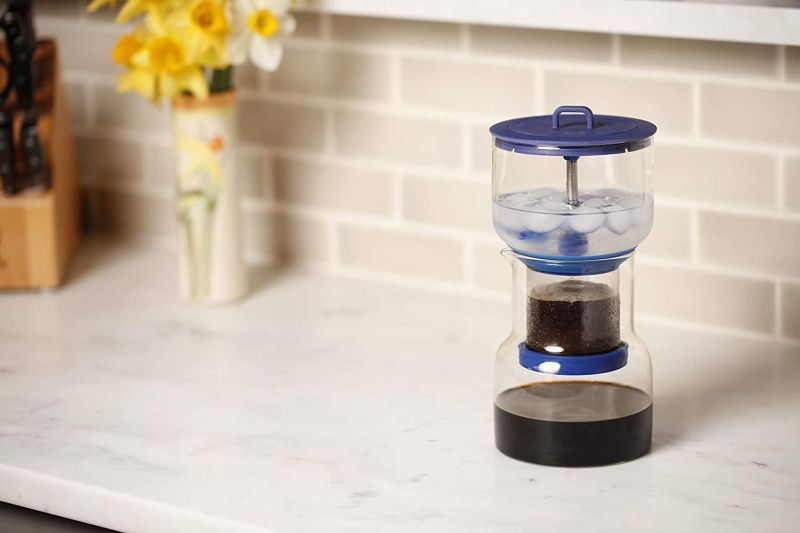
Cold Bruer Drip Coffee Maker B1 works on the principle of slow drip cold brew coffee. This is faster than the immersion method, but the brew is relatively weaker. And that’s okay, because this can be used directly as “regular” coffee, rather than the cold brew concentrate.
Add cold water (or ice cubes) to the glass tower and set a flow rate. Water droplets fall on the coffee grounds through a filter to disperse water evenly. Eventually, droplets make their way to the carafe and your brew is ready.
The carafe and water tower are made from glass. Stainless steel and silicone are used for valves and plugs. The coffee maker can make 20 oz of cold brew in about four hours. It is fairly strong coffee, though not as strong as conventional immersion brew.
Pros
- Cold brew is available faster
- High-quality construction
- Well-priced for a drip-style cold brew setup
Cons
- Cold brew is weaker than the immersion method
10. Dash Cold Brew Coffee Maker DCBCM550BK
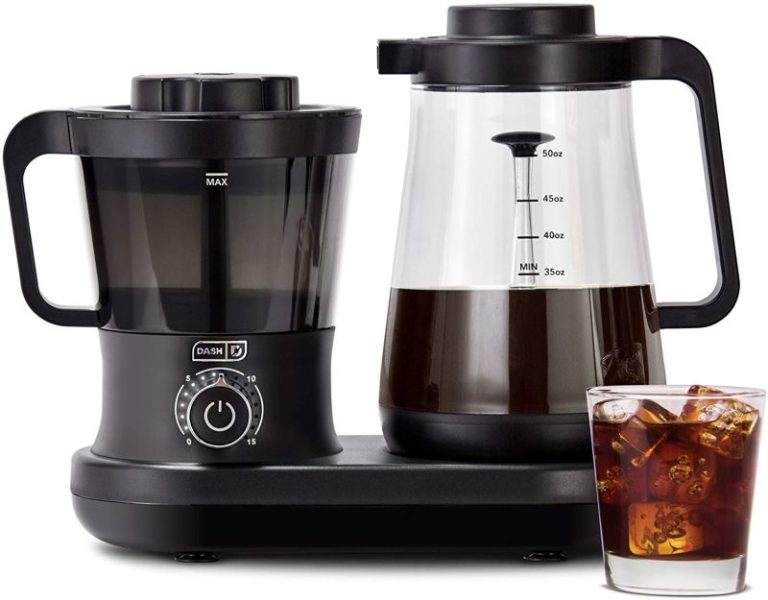
Cold brew coffee doesn’t always have to take hours to be done. Once you get electricity involved, the brew can be ready remarkably faster. Dash Cold Brew Coffee Maker DCBCM550BK uses electricity to make the cold brew coffee quicker.
For operation, the machine requires coffee grounds in the coffee container and water in the carafe. As the carafe is switched on, water is drawn from the carafe to the coffee container. A high-pressure system is created, and extraction occurs under pressure, but without the use of heat.
Soon enough, the increased pressure starts forcing coffee concentrate into the carafe, thus setting up your coffee concentrate. The use of electricity and pressure reduces the time requirements significantly. Dash claims it can get 42 oz of cold brew ready in just five minutes.
If you want the cold brew stronger, Dash Cold Brew Coffee Maker DCBCM550BK offers other intensity settings as well. A 10-minute medium brew and 15-minute dark brew options are available as well. The process is remarkably fast – cold brew that usually takes hours to a day is done in minutes!
Another popular coffee maker that uses electricity is the Cuisinart cold brew coffee maker DCB-10. Though both these machines make cold brew coffee exceedingly fast, they seem to lose some intricacies of flavor. This is still a decent and enjoyable brew, but it seems patience is rewarded where cold brew is concerned.
Pros
- Fast – cold brew coffee can be ready in 5-15 minutes
- Excellent extraction makes a strong drink
Cons
- Brew is not as flavorful as conventional cold brew
11. Primula Cold Brew Coffee Maker Burke Deluxe
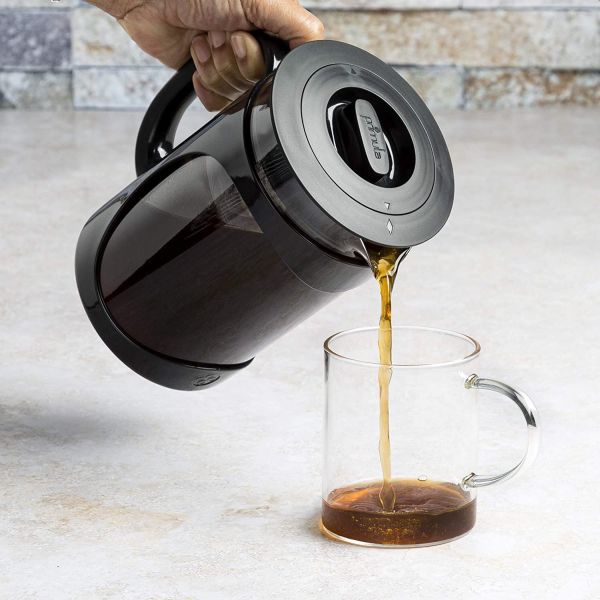
Primula Cold Brew Coffee Maker Burke Deluxe works fantastically with coffee, iced tea, and even as an infuser. Though it claims several of these talents, its real skill lies in making cold brew coffee. Burke Deluxe goes short and wide to be more compact and easily placed on refrigerator shelves.
This design also allows it better extraction from coffee beans, resulting in stronger, more enjoyable coffee concentrate. By all appearances, this is pretty much a regular container. However, as cold brew carafes go, the construction here is remarkably robust and durable.
Primula Burke Deluxe Cold Brew Coffee Maker carafe is made from borosilicate glass. The glass container is wrapped in a protective holder to keep it safe. A large handle makes it easier to maneuver this coffee maker.
Burke has a wide fine mesh filter placed inside, that allows plenty of possibilities for extraction. I think a wider mesh filter, like in the KitchenAid Cold Brew Coffee Maker is a huge plus. It’s a pity more cold brew coffee makers don’t use the same strategy.
Back to Primula Burke, the efficient and robust cold brew maker wins on its ease of use and easier management. And, its good quality at great value, so what’s not to love?!
Pros
- Excellent value for money
- Good quality carafe with robust construction and protection
- Easy to use
Cons
- The filter needs a finer mesh (grounds show up in brew)
12. Hario Mizudashi Cold Brew Coffee Pot
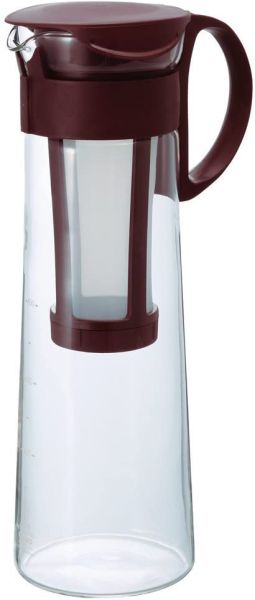
Hario Mizudashi Cold Brew Coffee Pot is a good path to cold brew coffee. The coffee maker takes on a long and slender profile over the conventional designs and looks. Apparently, this is a measure to save space and lower the footprint of the coffee maker.
One of the better known Japanese coffee maker companies, Hario has designed the Mizudashi quite skillfully. The unusual shape and the high-seated filter don’t look like a good combo, yet somehow the coffee maker makes it all works. The mesh on the filter is remarkably fine and ensures that coffee grounds don’t make their way into the brew.
Hario cold brew coffee maker delivers a smooth and strong coffee concentrate. Though it is slightly weaker than the competition. Well, I assume the high-strung filter is bound to have an effect on the coffee concentrate.
Pros
- Carafe made from high-quality heatproof glass
- Very fine mesh ensures that grounds don’t find their way into the concentrate
- Dishwasher safe
Cons
- Coffee concentrate is slightly weaker than its competitors
13. Willow & Everett Commercial Cold Brew Coffee Maker
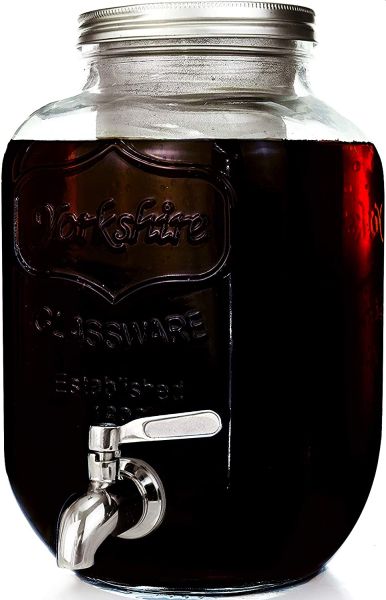
Willow & Everett Cold Brew Coffee Maker is a large glass pitcher with a spout at the end for easy delivery of cold brew. This isn’t essentially marketed to businesses, but it can work as a commercial cold brew coffee maker. That’s simply because it has a 1-gallon capacity, which should be enough for most businesses.
Given the presence of the spout, the dispensing mechanism is convenient enough and you get a steady stream of coffee concentrate. An opening at the top is used for adding water and coffee. The coffee maker uses a fine mesh filter that avoids spilling grounds into the concentrate.
Once your cold brew is ready, the filter can be easily removed. A sealing lid is placed at the top to keep the coffee fresh.
Pros
- Large, 1 gallon capacity
- Spout for easier delivery of cold brew
- Easy to use
Cons
- The filter is flimsy and tough to replace
- Large glass jar needs extra care
14. Yama Glass Cold Brew Maker
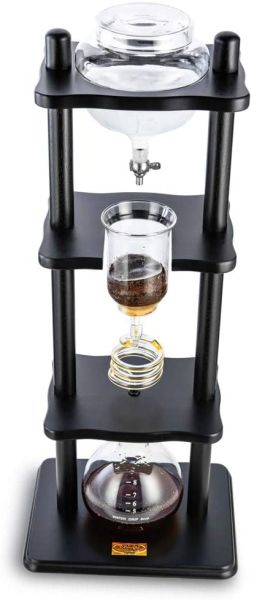
This is the cold brew maker with the coolest looks. It almost seems like a beautiful experiment in progress. Thankfully, the effort pays itself off with delicious coffee concentrate. Yama Glass Cold Brew Maker is a drip-style cold brew coffee maker that doesn’t fail to impress.
This coffee maker has a dramatic look that’s aesthetically pleasing. Equally so, the culinary skills are as remarkable and the brew is delicious. The four-tier system makes sure that the brew is strong and the extraction covers all bases.
You start with ice-cold water (or ice cubes) and open a valve to allow water to drip through to the coffee grounds. Eventually, water evenly soaks the grounds. The coffee moves on through an intricate helical system and drops to a carafe.
I have to say it feels over-engineered. But, without a doubt, it is a sight to behold. And over-engineered or not, the cold brew is second to none. Yama Glass Cold Brew Maker delivers 6-8 cups of concentrate in 3-4 hours.
It’s fairly quick, though the complexity requires this to be handled only by someone experienced with such systems. Also, I still can’t get over how cool it looks!
Pros
- Makes great cold brew
- Amazing looks and design
- Excellent user controls enable the user to freely tweak the system and control the quality and strength of the concentrate
Cons
- Expensive
- Very delicate setup
- Heavy (weighs more than 10 pounds)
What Is Cold Brew Coffee?
As its name implies, cold brew coffee is brewed cold. Conventionally, when brewing coffee, we use hot water for extraction, which makes the delicious coffee we all know and love.
Cold brew involves extraction at a lower temperature. Often, it involves the use of ice-cold water or placing the setup in a refrigerator. Since no heat is involved, extraction times are longer. You can spend several hours or even a day or more to complete cold brew extraction.
The long steeping time and low temperatures are surprisingly beneficial for coffee flavor and taste. Often, cold brew steers away from the bitter taste, highlights the fruity and floral undertones of coffee, and delivers a stronger cuppa.
Well, that sounds like everything we want from coffee. But then again, we’ve been making iced coffee for ages, so what changed?
Cold Brew VS Iced Coffee
If we are looking at icy cold coffee drinks, cold brew vs iced coffee is a sensible comparison. Even though the terms are sometimes used interchangeably, there is a difference in the preparation of both these brews.
When making iced coffee, we pretty much follow the same path as a conventional coffee cup. A regular cup of coffee is brewed using hot water and then poured over ice. Usually, we’ll make this cup of coffee extra strong to accommodate for the watering down effects of ice.
Coffee makers that offer the “over ice” function, generally use the same principle. The point to note is that coffee is brewed at high temperature, then cooled. Which brings us back to what is cold brew?
Cold brew essentially is coffee brewed at low temperature – even ice-cold water. It represents the temperature at which the extraction occurs, not the temperature of the serving. We usually enjoy cold brew coffee as a cold beverage.
However, the coffee concentrate from cold brew can also be added to hot water for a hot cuppa. You can also make some hot milk froth and combine it with cold brew concentrate for a wonderful cappuccino (or similar coffee recipes).
Pro tip: Cold brew with cold frothed milk makes a killer iced latte. That’s a quick cold brew coffee recipe you can try!
How To Make Cold Brew Coffee — The Delicious Brew Is Remarkably Easy
Cold brew coffee is surprisingly easy to make. It requires a small effort and an understanding of the basics. Let’s take a look at the basic methods and cold brew recipes.
Immersion Method Coffee Makers For Cold Brew Coffee
Immersion method is a simple and most popularly used method for cold brew coffee. Most of the coffee makers you see on our list here follow the immersion method. Immersion method involves placing coarse coffee grinds in cold water for a few hours.
Depending on how strong you want your cold brew, this can take 6 hours to a day. Many people prefer 14-16 hours, though the time is flexible. You can easily experiment with the time to find one that works best for you.
Once the steeping process is done, coffee grounds are removed using a filter and you’re left with coffee concentrate. The concentrate is strong and is usually diluted with water or milk before serving.
French Press Cold Brew — Does It Work?
People who want to learn how to make cold brew are best served with the immersion method. But what if you don’t want to invest your money in a cold brew coffee maker right away? Well, give the French Press cold brew a shot.
Of course, this method is best suited for people who already own a French press, which shouldn’t be difficult for coffee lovers. The process and recipe are similar to the immersion method.
We add cold water and coarse coffee grinds to the French press and put the plunger in position. Don’t push the plunger yet! The coffee grinds used should be slightly more coarse than French press coffee grounds.
Place the mix in a refrigerator. Once the immersion period is over, get the French press out of the refrigerator. Push the plunger, and pour the coffee concentrate.
If you have a quality French press with a useful filter, this shouldn’t be a problem at all. The clear cold brew is now available for use!
The problem with French press brewing is that the setup is not airtight. So, your coffee runs the risk of absorbing refrigerator smells and tasting weird. Secondly, the French press beaker is no place to store the coffee concentrate, mostly because it’s not airtight. You’ll either have to use the concentrate in one go or risk wasting it.
Cold Brew Drip Coffee Makers And Drip Brewing Process
Drip brewing process or slow drip method is another popular way for cold brew. It is faster than the immersion method, but the cold brew is weaker. The method also requires a more complicated setup. On the plus side, it enables the user to control various facets of the brewing process, which can be useful for experienced users.
In this method, droplets of iced water are poured over the coffee grounds. As these droplets make their way through the grounds, they are captured in a decanter. The cold brew is ready.
The process can take up to six hours to deliver a few ounces of coffee. However, it is relatively faster than the immersion method when you want just a few cups.
A big draw is that the setup can be visually stunning, as we see with the Yama Cold Brew maker on this list. Another cold drip coffee system in our cold brew coffee maker reviews is the Cold Bruer Drip Coffee Maker B1.
There are a few other specialty cold brew processes too. Though for home users, the immersion method and the slow drip method are the most relevant.
Got The Best Cold Brew Coffee Maker? Here Are A Few Things To Know
Cold Brew Coffee Ratio For A Better Brew
Here’s the first thing you should know: cold brewing will need more coffee grounds than other brewing methods. The coffee is being extracted at a lower temperature, and requires greater steeping time and contact time. Additionally, your coffee grounds have to be coarse, or at least slightly more coarse than French press.
The basic cold brew coffee ratio is that for every cup of water, you add an ounce by weight (28 grams) of coffee. Conventionally, this turns to adding half a cup of coffee for a cup of water.
Does Cold Brew Have More Caffeine
Cold brew is an interesting set up in the world of coffee. As we notice, it has a larger coffee to water ratio than other brewing methods. The brewing process lasts longer but is done at a cold temperature. So does cold brew have more caffeine or does the temperature change things?
It’s true for both! The lower temperature doesn’t cause as high a caffeine extraction as would be expected from the coffee volume involved. But the steeping time and coffee amount do lead to a higher caffeine concentration.
Keep in mind, cold brew coffee is made as a concentrate and will be cut with water, milk, or creamer before serving. As a generalization, cold brew has roughly 27 mg of caffeine per ounce. It’s not terribly high, but is a strong brew anyway.
How Long Does Cold Brew Last?
Once you have the concentrate ready, how long does the cold brew last? Assuming the concentrate is an airtight container and placed in a refrigerator, it will last two weeks. That said, consider it as the upper limit and not one to aspire to.
Cold brew concentrate lasts a long time (2 weeks) just like how coffee beans last a long time. But the time to get the best flavor and taste out of your coffee is lower. So don’t let the concentrate sit around for two weeks.
I’ll recommend you use the concentrate within one week. It can last two weeks easily, but the flavor starts to degrade after a week.
Cold Brew And Its Acid Content
Many coffee makers and tons of online publications claim that cold brew has a lower acid content. Claims often say that cold brew can have as low as 70% low acid content as compared to hot brew coffee. These claims are often used to market cold brew to people who want low acid coffee or have medical issues like GERD or heartburn.
There is no scientific evidence to suggest that cold brew has a remarkably lower acid content.
In fact, published papers see no major difference in the pH value of hot brewed drip coffee and cold brew coffee. Unfortunately, the (perceived) low acid content has become an oft-repeated myth and continues to be reported with cold brew.
If you’re looking at cold brew coffee simply for its low acid content, you’re looking in the wrong direction.
Best Coffee For Cold Brew
Practically, you can make cold brew with any coffee you like (just make sure the coffee grind is right). But there are other, more targeted options as well.
Given the popularity of cold brew, many companies offer coffee beans, grounds, or blends best suited for cold brew. Stone Street Coffee Cold Brew is a very popular pick with cold brew lovers. Although there are plenty of other well-regarded coffees for cold brew available.
Nitro Cold Brew At Home
Nitro cold brew is increasingly popular. Inspired in part by draught beer, it gives coffee a nice head of foam. Generally, nitrogen is the most preferred way to achieve the head, giving rise to the nitro cold brew. It’s popular, and it’s expensive. If you’re a regular consumer of this coffee you could save a lot by getting nitro cold brew at home, rather than at Starbucks.
Putting together cold brew coffee and a nitro brew system can have wonderful results. Best of all is that satisfying mouthfeel that only nitro cold brew can deliver! Our list here includes recommendations for nitro cold brew systems for home use.
Everything You Want To Know About Cold Brew Coffee Makers And Cold Brew
This guide is intended to give you a comprehensive understanding of cold brew and the coffee makers available. Cold brew is a delicious way to get your coffee and it’s remarkable for cold and hot coffee both. Though it is tough to beat when cold coffee is what you want!
Our recommendations for the best cold brew coffee maker are intended to be useful for making it easier for you to make the right choice. At the very least, we hope it brings more useful information for you.
The top recommendation is the Takeya Cold Brew Coffee Maker. Runner ups include the Toddy Cold Brew System, thanks to its very smooth and enjoyable brew.
